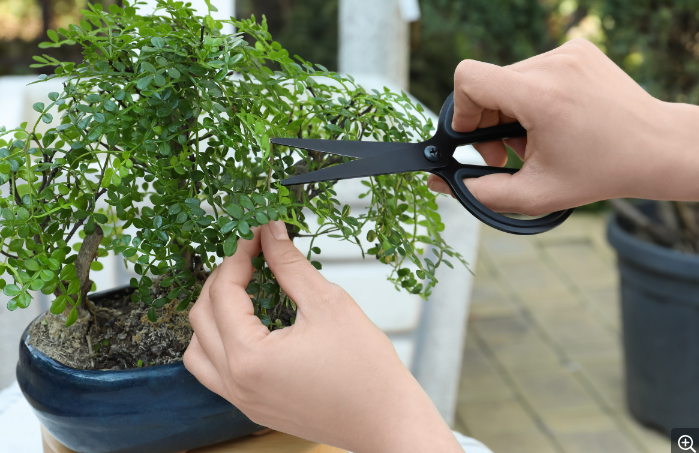Bonsai is a beautiful practice that not only introduces you to the art of creation, but also helps to reduce your stress and anxiety. When done correctly, bonsai can enhance your life and provide you with an activity that you can enjoy for years to come. But, many people struggle with the trimming of their bonsai. They fear that they might ruin the plant or the work they have already done.
Trimming a bonsai plant is not as difficult as it may seem. In fact, it is pretty simple, especially when you know what to look for and how to go about it. In this post, we will cover everything you need to know about how to trim your bonsai plant properly and keep it looking healthy and beautiful.
Regular pruning is essential for maintaining the health and aesthetic appeal of your bonsai tree. By strategically trimming overgrown branches and foliage, you not only preserve the desired shape but also promote better air circulation and light penetration, which are vital for the tree's overall vitality. Understanding the appropriate techniques and timing for pruning—such as performing structural cuts during the dormant season and maintenance trimming during the growing season—ensures optimal growth and development. Incorporating these practices into your bonsai care routine will help prevent disease, encourage dense foliage, and enhance the miniature tree's natural beauty.
Here are a few basic steps for trimming:
1. Understand Bonsai Basics Before Trimming
Before you start trimming your bonsai plant, it is essential to understand the basics of bonsai care. This will enable you to identify the right time to trim your plant, why you need to trim it, and how to go about it. A good bonsai grows well when the roots are healthy, and you need to ensure that the roots are not overcrowded by repotting it from time to time. When your bonsai plant has the healthy root system, it will grow strong and healthy, with beautiful leaves.
When is the Best Time to Trim a Bonsai?
Timing your bonsai trimming is key to success. Most bonsai species benefit from structural pruning in late winter or early spring before new growth begins. Light maintenance pruning can be done throughout the growing season to encourage compact foliage and preserve the design. Understanding your specific bonsai tree species is crucial to pruning at the right time.
Common Mistakes to Avoid When Pruning Bonsai
Beginners often make mistakes that can hinder bonsai growth. Over-pruning, cutting during the wrong season, or using dull tools can stress the tree or cause unsightly scars. It's important to prune with a plan—always visualize the shape you want and remove branches gradually. Avoid removing too much foliage at once, as it can weaken the tree.
2. Identify Where to Trim the Bonsai
The next step to follow when trimming your bonsai plant is to identify where to trim. It is essential to look closely at the plant's growth and development to know which areas need pruning. Start by identifying branches that are dead or damaged before removing them. Look for the thinner branches and shorter ones that may contribute to density and re-direct the plant's energy. Remember not to trim too much from the same part of the branch, or it will weaken and lead to problems over time. As a general rule, you should not remove more than 25% of the plant at one time.
3. Use the Right Trimming Tools
To trim your bonsai plant, you must use the right trimming tools. A pair of sharp scissors, branch shears, and concave cutters are the ideal tools for trimming and shaping your bonsai plants successfully. Be sure to keep the tools sharp and clean for effective trimming.
Visit our stores to get the most professional trimming tools: Click here for our store locations
4. Follow your natural shape and growth cycle of your bonsai
For trimming a bonsai, you can start by considering the plant's natural shape and its intention before starting trimming. It's always better to start slow and to remember that growth and development could take some time. Take caution by doing thinning or maintenance pruning regularly, and consider the fact that it will take longer for the new leaves to grow back when the bonsai is trimmed during winter.
5. Post-Trimming Care for Your Bonsai
After trimming, it is essential to take care of your bonsai properly. Place your bonsai in a well-lit area, but not exposed to direct sunlight. And watering is the next most important task for your bonsai plant. Watering involves a combination of knowing when to water and how much to water. Ensure that you have the right soil mixture to ensure proper water retention and to maintain the right level of moisture. Also, apply a good quality fertilizer to your bonsai to help boost its growth and keep it well-nourished.
In short, trimming your bonsai is not as complicated as it may seem. As you can see, with the right understanding and proper guidelines, you can do it successfully. By knowing where to trim, using the right trimming tools, following a general trimming routine, and taking care of your bonsai post-trim, you can significantly enhance the beauty of your plant and enjoy it for years to come. Follow these steps and make your bonsai trimming experience easier, stress-free, and successful.
